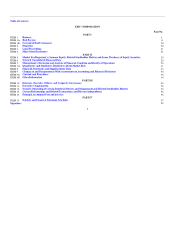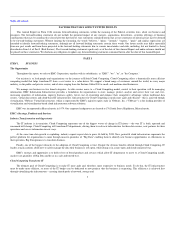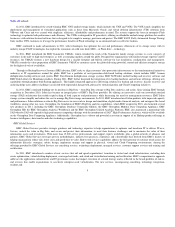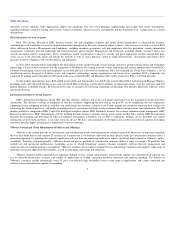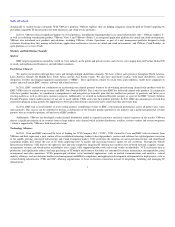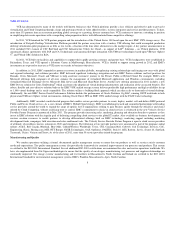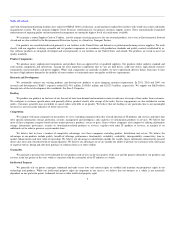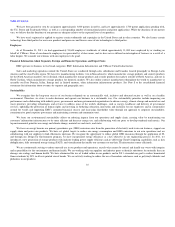EMC 2011 Annual Report Download - page 13
Download and view the complete annual report
Please find page 13 of the 2011 EMC annual report below. You can navigate through the pages in the report by either clicking on the pages listed below, or by using the keyword search tool below to find specific information within the annual report.
Table of Contents
the relative and varying rates of increases or decreases in component costs and product price, changes in product and services revenue mixture or decreased
volume could have a material adverse effect on our revenues, gross margins or earnings.
The costs of third-party components comprise a significant portion of our product costs. While we generally have been able to manage our component
and product design costs, we may have difficulty managing such costs if supplies of certain components become limited or component prices increase. Any
such limitation could result in an increase in our component costs. An increase in component or design costs relative to our product prices could have a
material adverse effect on our gross margins and earnings. Moreover, certain competitors may have advantages due to vertical integration of their supply
chain, which may include disk drives, microprocessors, memory components and servers.
The markets in which we do business are highly competitive, and we may encounter aggressive price competition for all of our products and services
from numerous companies globally. There also has been and may continue to be a willingness on the part of certain competitors to reduce prices or provide
information infrastructure and virtual infrastructure products or services, together with other IT products or services, at minimal or no additional cost in order
to preserve or gain market share. Such price competition may result in pressure on our product and service prices, and reductions in product and service prices
may have a material adverse effect on our revenues, gross margins and earnings.
If our suppliers are not able to meet our requirements, we could have decreased revenues and earnings.
We purchase or license many sophisticated components and products from one or a limited number of qualified suppliers, including some of our
competitors. These components and products include disk drives, high density memory components, power supplies and software developed and maintained
by third parties. We have experienced delivery delays from time to time because of high industry demand or the inability of some vendors to consistently meet
our quality or delivery requirements. Natural disasters, such as the recent flooding in Thailand affecting our disk drive component suppliers, have also in the
past and may continue to impact our ability to procure certain components in a timely fashion. Current or future social and environmental regulations or
critical issues, such as those relating to the sourcing of conflict minerals from the Democratic Republic of the Congo or the need to eliminate environmentally
sensitive materials from our products, could restrict the supply of resources used in production or increase our costs. If any of our suppliers were to cancel or
materially change contracts or commitments with us or fail to meet the quality or delivery requirements needed to satisfy customer orders for our products, we
could lose time-sensitive customer orders, be unable to develop or sell certain products cost-effectively or on a timely basis, if at all, and have significantly
decreased quarterly revenues and earnings, which would have a material adverse effect on our business, results of operations and financial condition.
Additionally, we periodically transition our product line to incorporate new technologies. The importance of transitioning our customers smoothly to new
technologies, along with our historically uneven pattern of quarterly sales, intensifies the risk that the failure of a supplier to meet our quality or delivery
requirements will have a material adverse impact on our revenues and earnings. An economic crisis may also negatively affect our suppliers' solvency, which
could, in turn, result in product delays or otherwise materially adversely affect our business, results of operations or financial condition.
Our financial performance may be impacted by the financial performance of VMware.
Because we consolidate VMware's financial results in our results of operations, our financial performance will be impacted by the financial
performance of VMware. VMware's financial performance may be affected by a number of factors, including, but not limited to:
• general economic conditions in their domestic and international markets and the effect that these conditions have on VMware's customers' capital
budgets and the availability of funding for software purchases;
• fluctuations in demand, adoption rates, sales cycles and pricing levels for VMware's products and services;
• fluctuations in foreign currency exchange rates;
• changes in customers' budgets for information technology purchases and in the timing of their purchasing decisions;
• VMware's ability to compete with existing or increased competition;
• the timing of recognizing revenues in any given quarter, which, as a result of software revenue recognition policies, can be affected by a number of
factors, including product announcements, beta programs and product promotions that can cause revenue recognition of certain orders to be deferred
until future products to which customers are entitled become available;
• the sale of VMware's products in the timeframes anticipated, including the number and size of orders in each quarter;
• VMware's ability to develop, introduce and ship in a timely manner new products and product enhancements that meet customer demand,
certification requirements and technical requirements;
• the introduction of new pricing and packaging models for VMware's product offerings;
• the timing of the announcement or release of upgrades or new products by VMware or by its competitors;
• VMware's ability to maintain scalable internal systems for reporting, order processing, license fulfillment, product delivery, purchasing, billing and
general accounting, among other functions;
12


